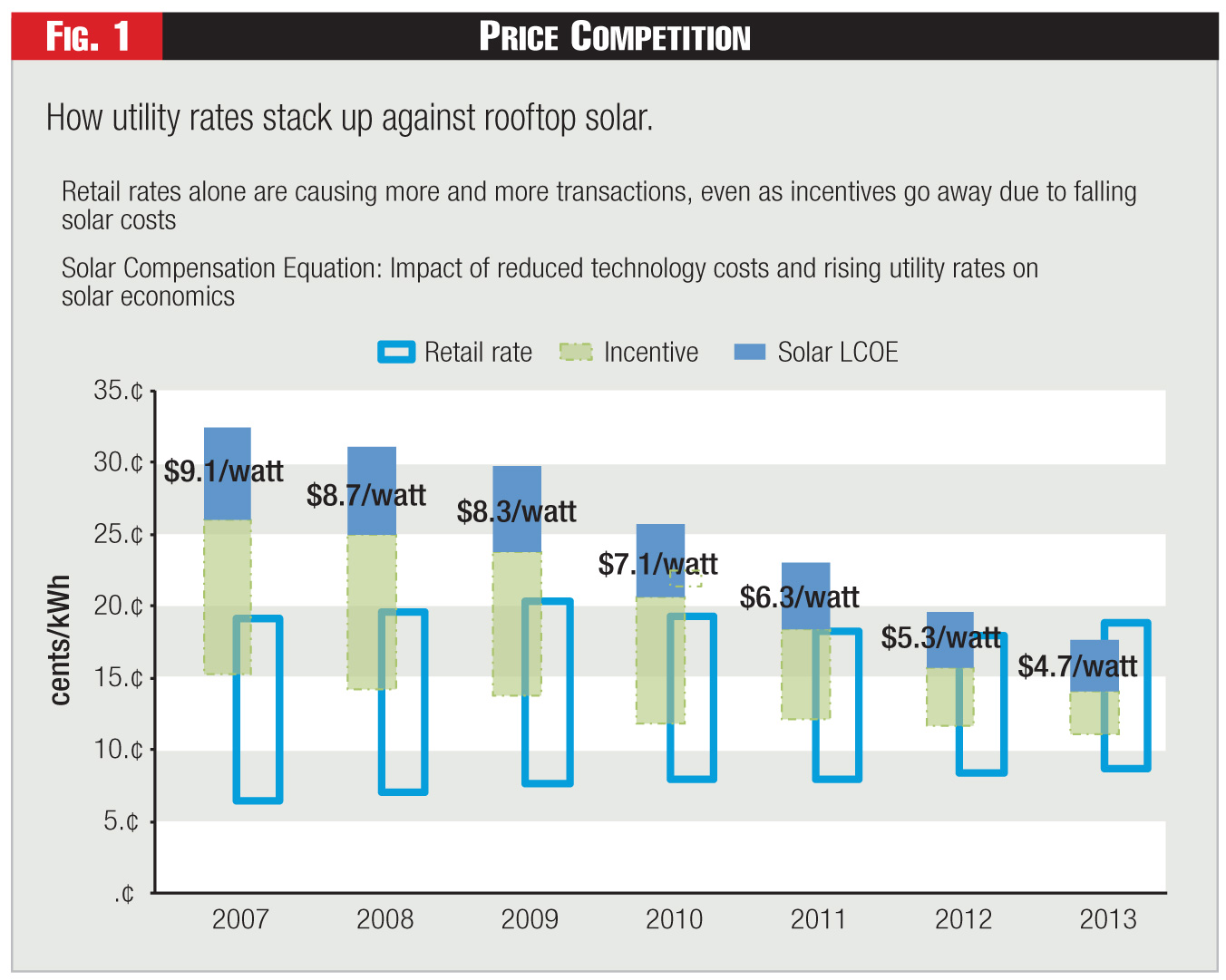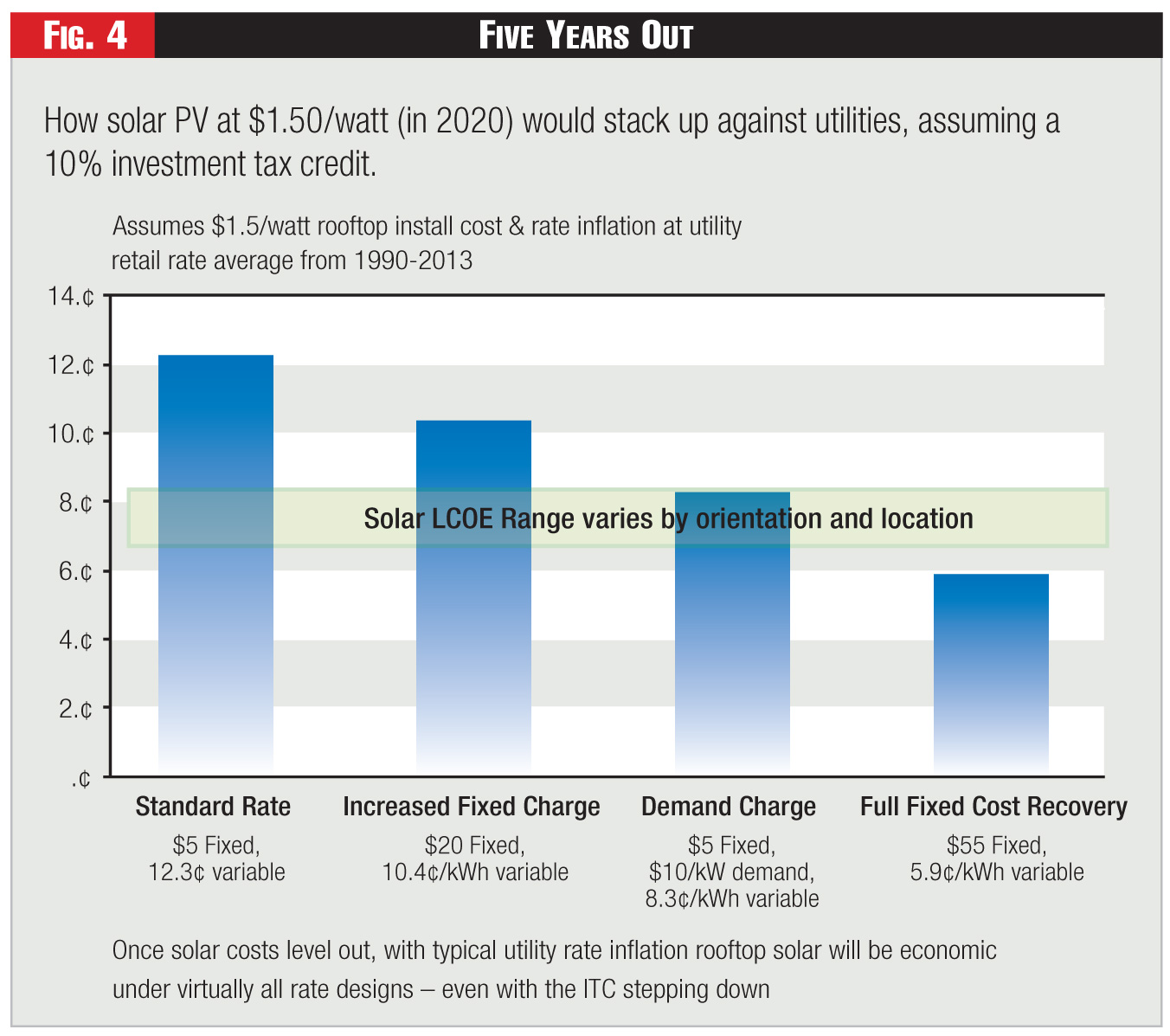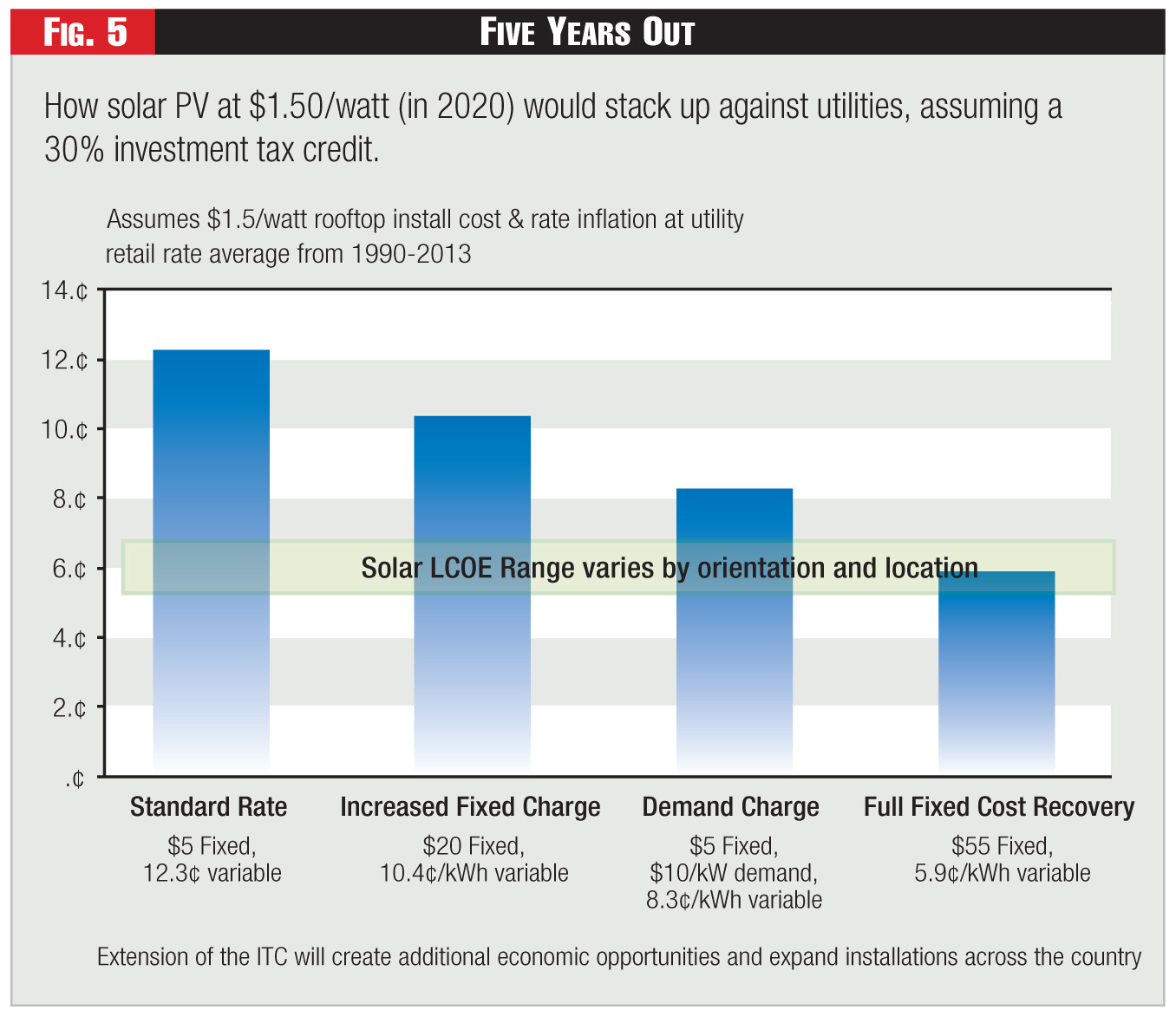A forward-looking solution to rate reform, for when solar costs hit bottom.
John Sterling is Senior Director of Research & Advisory Services for SEPA, the Solar Electric Power Association. Contact him at jsterling@solarelectricpower.org.
Clik here to view.

Clik here to view.

Clik here to view.

Clik here to view.

Clik here to view.

Distributed photovoltaic (PV) solar has taken off in recent years. Witness the nearly 1 gigawatt (GW) of new residential solar that was interconnected in 2014 alone. Indeed, this renewable resource has taken hold in many markets. It represents a tangible choice for consumers seeking to take control of their energy consumption.
Yet at the same time, this great success story is being undercut by the state-by-state debates over net energy metering and retail electricity rate reform now occurring across the country. The discussions surrounding these issues have become just as divisive and intensely fought as many other polarizing national debates.
These arguments are also extremely short-sighted. All the parties involved - utilities and developers alike - are focused on today's rate structures, today's solar costs and today's market. But with solar costs still in steady decline, this kind of tunnel vision is counterproductive. The solutions that utilities propose today will fall short in the coming years, as the costs of solar PV continue to fall.
What we need is a broader view of rate reform, based on a future with stably priced solar and the rates likely to be in effect when that price stability first occurs. Such a scenario - with rates that cover utilities' fixed costs while providing consumers with the right pricing signals - could generate attractive benefits for all stakeholders.
And so to that end I'm proposing that utilities consider a new type of rate design - one that's keyed to customer load factor and which would allow utilities to remain indifferent if their customers should choose to install rooftop solar PV. This new rate design would track demand and load factor in near real-time. By measuring the energy intensity of the retail customers, in terms of kilowatt-hours per square foot, with appropriate incentives and penalties, this rate design would be designed to encourage customers to maintain a steady usage profile, regardless of whether they're buying electricity from the utility, or generating their own power via rooftop solar.
After all, why keep rate design shackled to the ways of the past?
What Utilities Want
At the heart of current solar debates is the question of whether net metering at full retail rates will allow solar adopters to avoid paying for the fixed costs that utilities incur to maintain the grid, and instead shift those costs to non-solar customers. That question arises because the vast majority of utilities recover virtually all of their fixed costs to operate the system via variable rates, a relic of rate design that is decades old. As more and more customers choose to adopt solar PV and various other energy efficiency measures, such fixed costs may go under-recovered from those customers, and become imposed instead on all other customers, through increased variable rates in the next rate case.
Some utilities have stepped forward and proposed new rate design alternatives to address this cost shift. With few if any exceptions, these proposals have met with staunch opposition from many renewable energy advocates and solar developers. The reason for this hostility is simple: given current costs to install rooftop solar, these rate design alternatives would adversely impact the economics of solar adoption.
Attempts to fix this problem - whether by increasing the fixed component of the bill, implementing a demand charge, or transitioning toward pure, straight fixed-variable rate design (where rates reflect costs dollar for dollar) - will only reduce the likelihood that solar can be deployed in a cost-effective manner in the near term. Utilities proposing such changes are routinely accused of trying to "kill solar."
Conversely, many in the solar industry argue that the benefits of distributed solar - in the form of energy, deferred capital investments in grid upgrades, and environmental and societal benefits - will far outweigh the cost shift in question. Distributed solar is actually under-valued at retail rates, they argue.
From an individual consumer's perspective, receiving the highest price point possible via net metering is ideal, ensuring a quick break-even point and payback period for the investment made. But for customers as a whole, one could question whether maximizing the payment for solar and other distributed energy resources (DERs) is the most cost-effective approach to achieving our society's clean energy objectives.
Why It's Short-Sighted
As noted earlier, solar costs are still in decline and are anticipated to continue trending down for the next five to seven years before reaching a natural equilibrium of efficient manufacture and development. The U.S. Department of Energy's SunShot Initiative has targeted a national average for installed costs for residential rooftop solar of $1.50 per watt.
And while that price point may seem incredibly low, it is not unrealistic. In Montana, some solar developers anecdotally are reporting installed costs for residential solar below $2.80 per watt. Meanwhile, the market for utility-scale solar is seeing transactions at or below $1.40 per watt for large systems of more than 40 megawatts (MW).
On the other hand, as has been witnessed for over a decade, retail rates are likely to continue to climb higher into the future.
All of this brings us back to the future scenario of stably priced solar and the rates in effect when the point of stability is reached. At that moment, when we reach equilibrium, we will need utility rate designs that can survive in this new reality. And assuming simple rate inflation of approximately 3 percent per year and solar pricing at $1.50 per watt, all rate reform under general discussion today can and should be fully consistent with the market for solar transactions that will prevail during the early 2020s.
If we can design rates for this future scenario so that variable costs are recovered in a truly variable manner, and fixed costs are recovered rationally and fairly, then we can make utilities indifferent to solar adoption by customers. Utilities could afford to welcome as much solar as could be installed at the going price. And for the end consumer, the cost efficiencies gained for solar would translate into a continuing economic proposition that pencils out regardless of rate design.
From a societal perspective, this forward-looking approach also maximizes supply and demand curves with the most economic installation of solar across each service territory. Once solar reaches its optimum deployed cost, distributed solar developers will have an unfettered market because the utility will be, at the very least, indifferent and, at best, fully supportive of as much distributed PV as can be installed.
Technology developers also should welcome markets with better price transparency. Specifically, demand rates provide a financial incentive to deploy solar coupled with storage behind the meter, and host utilities are likely to be supportive of such customer investments.
Indeed, one might well argue that today's predominant rate design is actually hindering the full deployment of the technology on hand.
The way forward should include conscientious planning for a slow and measured transition period where incremental change in rate design is coupled with the introduction and subsequent sequential reduction and elimination of solar incentives. This approach can help ensure a smoother transition and a robust solar market with no abrupt interruptions due to rate changes.
Looking Beyond Rate Reform
Of course, rate reform remains but one component of a larger discussion on the future of the electric industry. As technologies advance, expectations placed upon the grid and its operators will become increasingly dependent on real-time information and integration of resources. Utilities necessarily will have to modify core business functions, and their regulators will be faced with redefining the roles and responsibilities not only of utilities and wholesale developers, but of each individual customer as well.
Recognizing the complex challenges and opportunities ahead, SEPA launched its 51st State Initiative in the fall of 2014. The goal of this project is to provide new ways for everyone to think and talk about the needed changes to our collective business models. Rather than focusing on how to fix policies, business models, and market structures that exist today, the 51st State provides an opportunity to re-invent the basics of electricity transactions. Over a dozen innovative ideas were submitted and can be found at www.sepa51.org.
The daunting challenge ahead is in charting a path forward so that utilities, developers, marketers, customers, and other industry players can all coexist, share risks, and maximize benefits.
The task becomes all the more complicated because we are not all starting from the same place. For example, integration of solar and other DERs in California, New York and Hawaii is at vastly different points from each other and from the rest of the country as well.
Utilities must shift their focus to the technologies needed to unleash the grid of the future. They must explain to their regulators the what's, when's, and why's associated with those investments. Industry players and technology providers must continue to drive down deployment costs and develop products and services that will meet the evolving needs of both customers and grid operators.
Supporting players - including standards agencies such as UL and IEEE - must adapt existing codes and standards to keep up with technological capabilities while enhancing the reliability and safety of the electric system.
Similarly, regulators will be faced with the difficult task of weighing the best interests of consumers as a whole today, as well as 10-15 years from now. Regulators will face key questions. Who plans, operates, funds, and maintains the distribution system? Who decides how the many different technologies will interact? Who decides whether customers will opt in or opt out of the dynamic platforms that provide energy services?
Moving past today's ephemeral arguments and toward structures that can endure - with well-vetted processes to manage the transition - can help reframe the conversation and allow for productive and collaborative dialogue.
SEPA is tackling this very issue in Phase II of the 51st State - because what the electric industry needs are clear road maps that outline how to move from the world of today to the world of tomorrow.
A Proposed New Rate Design
With incentives and penalties based on load factor.
Rate reform does not have to be shackled to historic retail rate design. In an ideal world, retail rate design would incentivize specific behaviors that are the most cost effective for utilities to serve. One such example would be designing rates to encourage a steady usage profile - or in utility parlance, a high load factor.
Load factor represents the efficiency of energy consumption over a given period of time. Take two extreme cases - one in which the customer has relatively steady energy consumption and another in which the customer has occasional heavy spikes in usage (see Figure 3).
Customer A is much cheaper to serve than Customer B. The utility's equipment is used more efficiently, so it can plan its system to a lower capacity requirement for virtually identical monthly energy needs.
If a utility is seriously looking to revise its retail rate structure, it should be identifying ways to incentivize customers to use energy much more efficiently. Rate design that promotes high load factors could be a key way to achieve that goal.
What a Load-Factor Rate Could Look Like
Instead of paying on a volumetric basis, customers' variable usage would be dissociated from their energy bill, with a standard rate offer based strictly on the peak demand of individual customers for a given month in a dollars per kilowatt (kW) - that is, demand-based - charge. Customers would be free to use as much energy as desired, as an incentive to maximize their load factor each month.
Customers with load factors exceeding a certain threshold would be eligible for a monthly bill discount, while customers with load factors below the threshold would be charged a usage penalty. In both cases, the thresholds would be varied by customer class. Monthly peak demand and load factor would be tracked and visible in near real-time via a web interface and smartphone app.
To promote energy efficiency, utilities would provide annual incentive payments to consumers who maintain an energy intensity of less than a predetermined kWh per square foot. Energy intensity would be tracked in near real-time, similar to the load factor data, and energy efficiency technologies would be required to be available for purchase directly from a utility web storefront.
By converting to a load factor-based rate design that explicitly incentivizes energy efficiency investments, utilities would be creating strong economic signals encouraging consumers to be smart about energy usage. Moreover, distributed energy resources, such as solar coupled with storage, could flourish in this environment by effectively managing peak demand.
Making the Transition
Transitioning to this kind of rate design - based on load factor and energy intensity - cannot occur overnight. For starters, customers have no concept today of what either of these terms mean. Moreover, load factor can be calculated with existing data streams, but energy intensity requires the collection of the area of each customer's residence or place of business. In fact, this transition must move through a series of requirements.
First comes deployment of advanced metering technology that is capable of real-time or near real-time communications and data integration. Real-time monitoring would be required at the feeder level, as would the deployment of advanced inverters.
Then comes a 12-month transition period where customers receive a dual bill showing both the old rate structure and the new LF/EI rate (with tips each month on ways to optimize both energy consumption and efficiency). Limited-income customers would be provided with free energy audits of their residences and credits for purchasing energy-efficient technologies from the utility's web storefront. For these customers, peak demand would reflect a specific peak window of time - rather than their single highest usage hour - so as to make saving money simpler.
Third, utilities and regulators would need to move toward more frequent rate cases, perhaps every two years, to ensure just and reasonable recovery of costs in this new paradigm.
Lastly, to ensure the most efficient deployment of capital across the entire system, utilities would need to file comprehensive resource plans that weigh supply and demand with distribution and transmission needs to create the optimal resource deployment mix. This planning process also would include a thoughtful, positive way to take into account the impact of customer-sited technologies on generation needs and distribution upgrades. -J.S.
Lead image © Taichesco | Dreamstime.com - Solar Cell Photo
Category (Actual):
Clik here to view.
